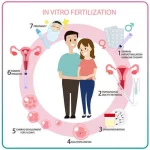
What Does IVF Cost? Your Guide to Understanding In Vitro Fertilization Expenses
April 9, 2025
What Does Lupron Do for IVF?
April 9, 2025What Did the IVF Bill Contain? A Deep Dive into Its Impact and Meaning

What Did the IVF Bill Contain? A Deep Dive into Its Impact and Meaning
In recent years, in vitro fertilization (IVF) has become a hot topic—not just in doctor’s offices or family planning discussions, but in the halls of government too. If you’ve heard about “the IVF bill” and wondered what it’s all about, you’re not alone. It’s a big deal for millions of people hoping to start a family, and it’s stirred up debates across the U.S. So, what exactly did this bill contain? Why does it matter? And how might it affect you or someone you know? Let’s break it all down in a way that’s easy to grasp, with some fresh insights you won’t find everywhere else.
The Basics: What Was the IVF Bill Trying to Do?
At its core, the IVF bill—officially known as the Right to IVF Act (S.4445 in the 118th Congress)—was designed to make sure people across the United States could access IVF and other fertility treatments without roadblocks. Introduced in June 2024 by Senator Tammy Duckworth of Illinois, this bill came at a time when IVF was facing new challenges, especially after some state laws started treating embryos in ways that made fertility clinics nervous.
The bill wasn’t just one idea—it was a package of plans rolled into one. Think of it like a toolbox: each part had a job to do, from protecting your right to try IVF to helping cover the costs. It aimed to tackle real problems people face, like sky-high prices or legal confusion, while keeping IVF safe and available nationwide.
Here’s the big picture: the Right to IVF Act wanted to give you the freedom to build your family your way, without politicians or insurance companies standing in the way. Sounds simple, right? But there’s a lot more under the hood.
Breaking Down the Key Pieces of the IVF Bill
So, what was actually in this bill? Let’s unpack it step-by-step, like opening a gift to see what’s inside.
A Legal Right to IVF Access
One of the biggest parts was creating a statutory right—that’s a fancy way of saying a guaranteed freedom—to use IVF. This meant:
- You could decide to try IVF without extra rules or limits from your state.
- Doctors and clinics could offer IVF services without worrying about lawsuits or bans.
- Even your embryos (those tiny bundles of cells created during IVF) would be yours to manage, free from outside meddling.
Why was this a big deal? Because in early 2024, an Alabama Supreme Court ruling called frozen embryos “children.” That freaked out clinics—they paused IVF services, leaving families in limbo. The bill said, “No more of that.” It aimed to override state laws that mess with IVF, so you wouldn’t have to wonder if your state might shut it down.
Insurance Coverage for Fertility Treatments
IVF isn’t cheap. A single cycle can cost $12,000 to $25,000, and most people need more than one try. The bill wanted to lighten that load by making insurance pick up some of the tab. Here’s how:
- Private insurance: If your health plan covers pregnancy stuff (like delivering a baby), it’d have to cover IVF too.
- Medicare and Medicaid: These government programs would start helping with fertility costs for eligible folks.
- Military and veterans: Service members and vets would get better access to IVF, including options like freezing embryos before deployment.
Imagine you’re a teacher or a nurse—someone who works hard but doesn’t have a fortune to spare. This part of the bill could mean the difference between starting a family or giving up the dream.
Protections for Providers and Manufacturers
The bill didn’t just focus on patients. It also had the backs of the people making IVF possible:
- Doctors and clinics could keep doing their jobs without fear of legal trouble.
- Companies making fertility drugs or equipment (like those high-tech incubators for embryos) wouldn’t face random restrictions.
This was about keeping the whole IVF system running smoothly. If providers are scared off, no one gets help.
Pushing Back Against State Restrictions
Some states have laws that make IVF trickier—like rules saying only married couples can use it, or that embryos can’t be discarded. The Right to IVF Act said those limits don’t fly. It would override them, giving everyone—single folks, same-sex couples, anyone—the same shot at IVF. But it still let states set basic safety rules, like making sure clinics are clean and legit.
Why Did the IVF Bill Matter So Much?
IVF isn’t just a medical procedure—it’s a lifeline for people who can’t have kids the usual way. About 1 in 8 couples struggle with infertility, according to the CDC. That’s millions of Americans. The bill mattered because it touched real lives, not just politics.
Take Sarah, a 34-year-old from Ohio. She and her husband spent years trying to conceive naturally. After two miscarriages, their doctor suggested IVF. But their insurance wouldn’t cover it, and they couldn’t swing the $15,000 price tag. If the bill had passed, Sarah might’ve had a chance without draining their savings.
Then there’s the legal side. After the Alabama ruling, clinics hit pause. Couples mid-treatment were left hanging—some even had to move embryos out of state. The bill wanted to stop that chaos, giving families and doctors peace of mind.

What Happened to the Bill? The Senate Showdown
Here’s where things get messy. The Right to IVF Act hit the Senate floor twice—once in June 2024 and again in September 2024. Both times, it failed to pass. Why? It needed 60 votes to move forward, but it only got 51-44 the second time around. Most Republicans voted no, even though some, like Donald Trump, said they supported IVF.
So, what went wrong? Critics—like Senator Cindy Hyde-Smith from Mississippi—argued the bill went too far. They worried it could greenlight wild stuff like human cloning or force religious doctors to do things they didn’t believe in. Supporters, like Senator Duckworth (who used IVF to have her kids), said that was nonsense—it was just about protecting a treatment millions rely on.
The vote turned into a political tug-of-war. Democrats pushed it to show they’re fighting for families; Republicans called it a “stunt” to make them look bad before the 2024 election. Meanwhile, families waiting for IVF were stuck watching the drama unfold.
Fresh Angles: What Other Articles Missed
Most stories about the IVF bill stick to the basics—what it said, who voted for it, why it failed. But there’s more to dig into. Here are three points you won’t find everywhere else, with some extra depth to chew on.
The Ripple Effect on Embryo Storage
One thing the bill didn’t spell out—but totally affects you—is how it could’ve changed embryo storage. Right now, if a state says embryos are “people,” clinics might have to keep them frozen forever. That’s a nightmare for families who don’t want more kids and for clinics running out of freezer space. The bill’s override of state limits could’ve let you decide what happens to your embryos—use them, donate them, or let them go—without legal headaches.
Practical Tip: If you’re thinking about IVF, ask your clinic about their storage policies now. Some charge $500-$1,000 a year to keep embryos frozen, and that adds up fast.
The Economic Boost No One Talks About
IVF isn’t just personal—it’s big business. In 2021, over 85,000 babies were born via IVF in the U.S., per the Department of Health and Human Services. That’s a lot of jobs for doctors, nurses, and lab techs. If the bill made IVF more affordable, more people might use it, pumping money into local economies. Think Washington D.C.’s cherry blossom season—it brings in hundreds of millions. IVF could do something similar for healthcare hubs.
Quick Stat: A 2023 study from the American Society for Reproductive Medicine estimated IVF supports over 50,000 jobs nationwide. More access could double that.
The Mental Health Angle
Infertility is tough—emotionally and mentally. Studies show 40% of women dealing with it face depression, says the National Institutes of Health. The bill’s insurance piece could’ve eased that stress by cutting costs. But since it didn’t pass, families are still stuck juggling hope and heartbreak. No one’s really talking about how this bill could’ve been a mental health win too.
Try This: If IVF’s on your radar, join a support group (online or in-person). Talking it out with people who get it can lighten the load.
Interactive Check-In: How Much Do You Know About IVF?
Let’s pause for a sec. Test your IVF smarts with this quick quiz—it’s just for fun, no pressure!
- How much does one IVF cycle usually cost?
- A) $5,000
- B) $12,000-$25,000
- C) $50,000
- What’s one reason clinics paused IVF in Alabama?
- A) Too expensive
- B) A court said embryos are “children”
- C) New taxes
- Who introduced the Right to IVF Act?
- A) Donald Trump
- B) Tammy Duckworth
- C) Chuck Schumer
(Answers: 1-B, 2-B, 3-B. How’d you do? Drop your score in your head and keep reading!)
Comparing the IVF Bill to Other Plans
The Right to IVF Act wasn’t the only game in town. Republicans like Senators Katie Britt and Ted Cruz had their own bill—the IVF Protection Act. So, how do they stack up?
| Feature | Right to IVF Act (Democrats) | IVF Protection Act (Republicans) |
|---|---|---|
| Legal Right to IVF | Yes, nationwide | No, just stops outright bans |
| Insurance Coverage | Yes, private and public plans | No, focuses on health savings accounts |
| Overrides State Laws | Yes, for restrictions | No, lets states set most rules |
| Military/Veteran Help | Yes, expands access | No specific mention |
The Republican plan was narrower—it wouldn’t let states ban IVF outright (by tying it to Medicaid funding), but it didn’t touch costs or big legal protections. Democrats went all-in, aiming to fix access and affordability. Which one’s better? Depends on what you value—freedom from bans or a full-on support system.

What’s Next for IVF Access?
The bill’s failure doesn’t mean IVF’s dead in the water. States like California are stepping up—Governor Gavin Newsom signed a law in September 2024 making big insurance plans cover IVF. Other states might follow, creating a patchwork of rules. Meanwhile, President Trump signed an executive order in February 2025 pushing for cheaper IVF, though it’s light on details so far.
But here’s the catch: without a federal law, your access depends on where you live. If you’re in a state with strict embryo laws, you might face hurdles. And costs? Still a huge barrier for most.
Action Steps for You:
- ✔️ Check your insurance—some plans cover diagnostics (like testing why you’re infertile) even if they skip IVF.
- ❌ Don’t assume your state’s laws won’t change—keep an eye on local news.
- ✔️ Look into fertility grants—groups like Baby Quest offer up to $15,000 for treatments.
Real Stories: How IVF Laws Hit Home
Let’s get personal. Meet Jake and Maria, a couple from Texas. They started IVF in 2023, before the bill came up. Their clinic warned them: if Texas tightens embryo rules, their frozen embryos might be stuck in limbo. They’re still waiting, hoping for clarity. “It’s like we’re betting our future on politics,” Maria says.
Then there’s Aisha, a single woman in New York. She wants to use IVF with a donor, but her insurance says no—single folks don’t qualify. The bill could’ve forced a change, but now she’s scraping by with loans. “I just want a kid,” she says. “Why’s it this hard?”
These aren’t just stories—they’re why the bill’s details matter. It’s not abstract; it’s people.

Vote Time: What Do You Think?
Here’s a quick poll to keep you engaged: Should the government make IVF more affordable?
- Yes, everyone deserves a shot at a family.
- No, it’s too expensive for taxpayers.
- Maybe, but only for certain groups (like veterans).
Think about it—what’s your take? It’s a question that’s still bouncing around in 2025.
The Bigger Picture: IVF and Society
Zoom out for a minute. IVF isn’t just about babies—it’s about who we are as a country. The U.S. fertility rate hit a record low in 2023 (down 3% from 2022, per the CDC). More families via IVF could shift that. Plus, it’s a fairness thing—why should only rich folks get to use it?
But there’s pushback. Some worry about “designer babies” or ethical lines. Others say taxpayers shouldn’t foot the bill. The Right to IVF Act tried to balance all that, but the debate’s far from over.
Fun Fact: Over 8 million babies have been born via IVF worldwide since 1978, per Columbia University. That’s a small city’s worth of people!
Wrapping Up: What the IVF Bill Means for You
The Right to IVF Act was a bold swing at making fertility treatment a right, not a privilege. It packed in legal protections, insurance help, and a shield against state overreach. Sure, it didn’t pass—yet—but it’s sparked a conversation that’s not going away. Whether you’re planning a family, supporting a friend, or just curious, this bill’s story shows how personal and political collide.
So, what can you do? Stay informed. Talk to your doctor. Push your lawmakers if it matters to you. IVF’s future isn’t set in stone, and your voice could shape it. For now, the bill’s a blueprint—a map of what could be, if we decide it’s worth fighting for.

